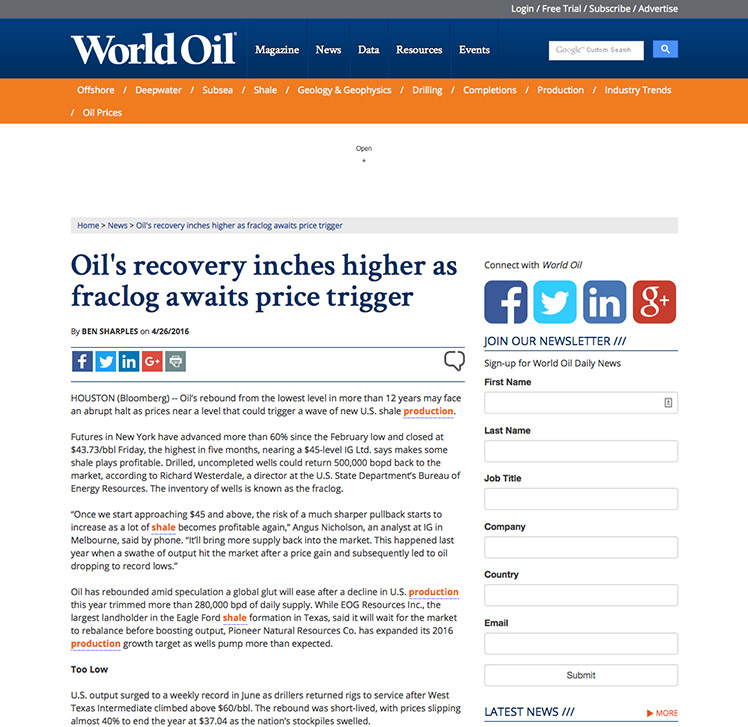Oil’s rebound from the lowest level in more than 12 years may face an abrupt halt as prices near a level that could trigger a wave of new U.S. shale production. Futures in New York have advanced more than 60% since the February low and closed at $43.73 a barrel Friday 22nd March, the highest in five months, nearing a $45-level IG Ltd. says makes some shale plays profitable. Drilled, uncompleted wells could return 500,000 barrels of oil per day back to the market, according to Richard Westerdale, a director at the U.S. State Department’s Bureau of Energy Resources. The inventory of wells is known as the fraclog. “Once we start approaching $45 and above, the risk of a much sharper pullback starts to increase as a lot of shale becomes profitable again,” Angus Nicholson, an analyst at IG in Melbourne, said by phone.
Details
 Africa’s government may award its first shale gas exploration licenses by the end of September, after environmental objections delayed the process.
Africa’s government may award its first shale gas exploration licenses by the end of September, after environmental objections delayed the process. 

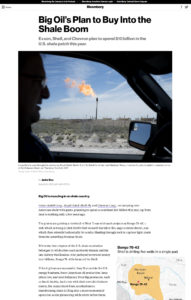 Exxon Mobil, Royal Dutch Shell and Chevron plan to spend a combined $10 billion this year in American shale.
Exxon Mobil, Royal Dutch Shell and Chevron plan to spend a combined $10 billion this year in American shale. 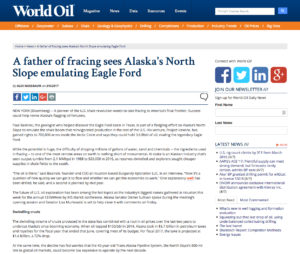 A pioneer of the U.S. shale revolution, Paul Basinski, wants to take fracking to America’s final frontier – Alaska.
A pioneer of the U.S. shale revolution, Paul Basinski, wants to take fracking to America’s final frontier – Alaska. 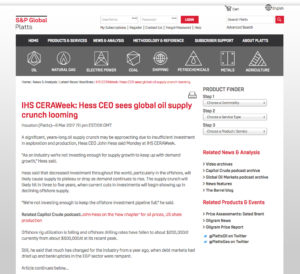 A significant, years-long oil supply crunch may be approaching due to insufficient investment in exploration and production, Hess CEO John Hess said at the IHS CERAWeek, and this will begin showing up in declining offshore supply. He added that “The shale business is back in business and starting to grow again,” but such growth in US shale would not be enough to meet global oil demand, which the International Energy Agency has projected to grow between 1.4-1.6 million barrels a day over this year and the next.
A significant, years-long oil supply crunch may be approaching due to insufficient investment in exploration and production, Hess CEO John Hess said at the IHS CERAWeek, and this will begin showing up in declining offshore supply. He added that “The shale business is back in business and starting to grow again,” but such growth in US shale would not be enough to meet global oil demand, which the International Energy Agency has projected to grow between 1.4-1.6 million barrels a day over this year and the next.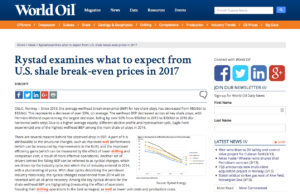 Since 2013, the average wellhead break-even price (BEP) for key shale plays has decreased from $80 a barrel to $35/bbl. This represents a drop of over 55%, on average. The wellhead BEP decreased across all key shale plays, with Permian Midland falling by over 60% from $98/bbl in 2013 to $38/bbl in 2016 (for horizontal wells only). Rystad Energy forecasts an average WTI oil price of $60/bbl, which implies a 40% improvement in the cash from operations. This improvement will result in higher investments of the shale operators.
Since 2013, the average wellhead break-even price (BEP) for key shale plays has decreased from $80 a barrel to $35/bbl. This represents a drop of over 55%, on average. The wellhead BEP decreased across all key shale plays, with Permian Midland falling by over 60% from $98/bbl in 2013 to $38/bbl in 2016 (for horizontal wells only). Rystad Energy forecasts an average WTI oil price of $60/bbl, which implies a 40% improvement in the cash from operations. This improvement will result in higher investments of the shale operators.